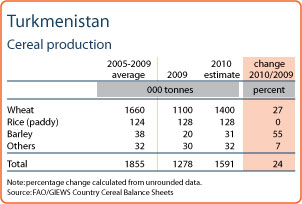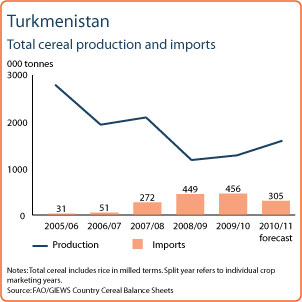Turkmenistan: Turkmenistan Agriculture Profile 2012
2012/04/05
Turkmenistan Agriculture Profile 2012
|
FOOD SECURITY SNAPSHOT
|
Weather conditions are favourable for 2011 crop production
Weather conditions since the beginning of the cropping season have been generally favourable for the 2011 cereal crops. Good precipitation since March 2011 contributed to improve soil moisture for development of winter crops and planting of spring crops. Wheat production, accounting for 88 percent of total cereal production, is officially forecast at around 1.5 million tonnes, 11 percent higher than last year’s level mainly reflecting expected higher yields. The supply of agricultural inputs is arranged centrally and controlled by the state authorities. Inputs are imported from USA, Belarus and Ukraine, except for fertilizers that are domestically produced.
Cereal import requirements significantly decreased in the past two years
Following increased harvests in 2019 and 2010, imports of cereals have significantly dropped in the past two marketing years (July/June) The bulk of cereals imports are in the form of wheat to cover production deficits and also due to the low quality of the wheat produced in the country. In marketing year 2010/11, cereal import requirements are estimated at 75 000 tonnes.
Food insecurity remains a concern for low-income population
The Government regulates prices of basic foods. The country has large revenue from the export of energy resources which are used to subsidy staple food products through the distribution of a certain volume of wheat flour to all vulnerable population. However, due to high unemployment, in particular in rural areas, food insecurity persists among low-income groups of the population.
08/12/2010 The 2010 crops production increases due to favourable weather and larger plantings

Crop production in 2010 is forecast to rise as compared to the previous two years, but to remain below the five-year average. Favourable weather and larger plantings have resulted in an increase in cereal output by 24 percent from the previous year. The authorities of the country consistently stimulated cereals production, mainly wheat, which covers around 45-50 percent of the total planted area under all crops. The country produces a significant volume of cotton, which is mostly exported and accounts for about 30 percent of total crop output.
The increased cereals production of about 1.59 million tonnes in 2010 has been achieved by expanding the area planted by 11 percent above the five-year average, but yields per hectare have remained significantly lower compared with the five-year average.
Harvesting of the 2010 cereal crop is almost complete. Meanwhile sowing of winter cereals for harvest in 2011 is ongoing. Favourable weather conditions for winter wheat planting have been observed so far.
The supply of most inputs required for agriculture production is arranged centrally and controlled by the state authorities. Inputs are imported from USA, Belarus, and Ukraine, but most of the fertilizer requirement is produced inside the country. However, the country suffers from chronic water shortages and soil degradation which cause major problems for farmers and other agriculture producers.
Around 25 percent of domestic needs in cereals are covered by import, mainly of wheat

Turkmenistan is a regular importer of cereals, with domestic production covering about 75 percent of domestic needs in cereals in recent years. The bulk of cereals imports are in the form of wheat also due to the low quality of wheat produced in the country. Wheat imports will cover about 40 percent of wheat consumed as food in the 2010/11 marketing year (July-June). The country has a large revenue from the export of energy resources which are used by the Government to finance the import of needed food supplies.
Food security issues

The state authorities regulate the prices on basic foods and provide food subsides. For food security purposes the Government practices the distribution of a certain volume of wheat flour to all population. The quality of local flour and flour products is still poor and therefore a large volume of foodstuff is imported for food consumption. Due to high unemployment and malnutrition in particular in rural areas, food security is at risk especially for vulnerable groups.
- Turkmenistan News
-
- AFGHANISTAN: UNWTO: International tourism – strongest half-year results since 2010
- CHINA: Turkmenistan should cultivate diverse gas markets
- AFGHANISTAN: Higher earning Why a university degree is worth more in some countries than others
- AFGHANISTAN: Central Asian countries, EU to mull issues of co-op
- AZERBAIJAN: Central Asian countries, EU eye economic development
- TURKMENISTAN: IDB to finance Turkmen section of TAPI gas pipeline
- Trending Articles
-
- CHINA: China welcomes Guinea to take part in Belt and Road Initiative
- UNITED STATES: Spotify, Hulu target students with discounted bundle
- UGANDA: Ugandan Govt Starts Verifying International Academy Teachers
- CAMEROON: Poor End of Year Results for Cameroon Students
- JAPAN: How Honda lost its mojo - and the mission to get it back
- AUSTRALIA: Queensland Bauxite Gains State Approval of Mineral Development Work Program












